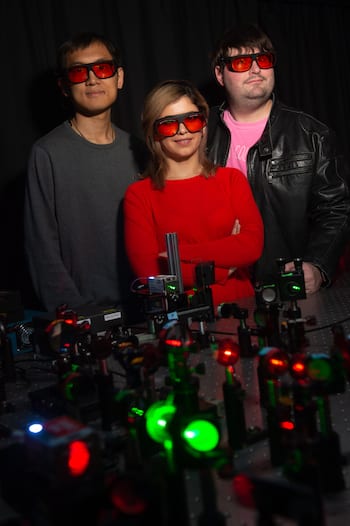NEWS RELEASE
Editor’s note: Links to high-resolution images for download appear at the end of this release.
David Ruth
713-348-6327
david@rice.edu
Mike Williams
713-348-6728
mikewilliams@rice.edu
Plasmonic pioneers fire away in fight over light
Rice University lab argues for photoluminescence as phenomenon that triggers emissions
HOUSTON – (Jan. 28, 2019) – When you light up a metal nanoparticle, you get light back. It’s often a different color. That’s a fact – but the why is up for debate.
In a new paper in the American Chemical Society journal Nano Letters, Rice chemist Stephan Link and graduate student Yi-Yu Cai make a case that photoluminescence, rather than Raman scattering, gives gold nanoparticles their remarkable light-emitting properties.

Rice University researchers argued for the dominance of photoluminescence as the source of light emitted by plasmonic metal nanoparticles in a new paper. Their techniques could be used to develop solar cells and biosensors. Illustration by Anneli Joplin
The researchers say understanding how and why nanoparticles emit light is important for improving solar-cell efficiency and designing particles that use light to trigger or sense biochemical reactions.
The longstanding debate, with determined scientists on either side, is about how light of one color causes some nanoparticles to emit light of a different color. Cai, the paper’s lead author, said the debate arose out of semiconductor research in the 1970s and was more recently extended to the field of plasmonic structures.
“The Raman effect is like a ball that hits an object and bounces off,” Cai said. “But in photoluminescence, the object absorbs the light. The energy in the particle moves around and the emission comes afterwards.”

Rice University researchers are looking into the source of light emitted by plasmonic metal nanoparticles. In a new paper, they argue for the dominance of photoluminescence as opposed to Raman scattering. From left: Yi-Yu Cai, Behnaz Ostovar and Lawrence Tauzin. Photo by Jeff Fitlow
Eight years ago, Link’s research group reported the first spectroscopy study on luminescence from single plasmonic nanorods, and the new paper builds upon that work, showing that the glow emerges when hot carriers – the electrons and holes in conductive metals – are excited by energy from a continuous wave laser and recombine as they relax, with the interactions emitting photons.
By shining specific frequencies of laser light onto gold nanorods, the researchers were able to sense temperatures they said could only come from excited electrons. That’s an indication of photoluminescence, because the Raman view assumes that the equilibrated temperature of phonons, not excited electrons, are responsible for light emission.
Link and Cai say the evidence appears in the efficiency of anti-Stokes as compared to Stokes emission. Anti-Stokes emission appears when a particle’s energetic output is greater than the input, while Stokes emission, the subject of an earlier paper by the lab, appears when the reverse is true. Once considered a background effect related to the phenomenon of surface-enhanced Raman scattering, Stokes and anti-Stokes measurements turn out to be full of useful information important to researchers, Cai said.
Silver, aluminum and other metallic nanoparticles are also plasmonic, and Cai expects they’ll be tested to determine their Stokes and anti-Stokes properties as well. But first, he and his colleagues will investigate how photoluminescence decays over time.
“The direction of our group moving forward is to measure the lifetime of this emission, how long it can survive after the laser is turned off,” he said.
Co-authors of the paper are Rice alumni Eric Sung, Runmin Zhang, Jun Liu, Yue Zhang and Wei-Shun Chang; research scientist Lawrence Tauzin; graduate student Behnaz Ostovar, and Peter Nordlander, a professor of physics and astronomy, of electrical and computer engineering and of materials science and nanoengineering. Link is a professor of chemistry and of electrical and computer engineering.
The research was supported by the Robert A. Welch Foundation, the Air Force Office of Scientific Research via the Department of Defense Multidisciplinary University Research Initiative and the National Science Foundation.
-30-
Read the abstract at https://pubs.acs.org/doi/10.1021/acs.nanolett.8b04359
Follow Rice News and Media Relations via Twitter @RiceUNews
Related materials:
Link Research Group: http://slink.rice.edu/members/slink/
Nordlander Nanophotonics Group: http://nordlander.rice.edu/home
Wiess School of Natural Sciences: https://naturalsciences.rice.edu
Images for download:
https://news2.rice.edu/files/2019/01/0129_STOKES-1-WEB-19l9ih8.jpg
Rice University researchers argued for the dominance of photoluminescence as the source of light emitted by plasmonic metal nanoparticles in a new paper. Their techniques could be used to develop solar cells and biosensors.(Credit: Illustration by Anneli Joplin/Rice University)
https://news2.rice.edu/files/2019/01/0129_STOKES-2-WEB-1l3zxcj.jpg
Rice University graduate student Yi-Yu Cai adjusts a microscope to focus on gold nanorods, the target of new research into the source of useful light emissions from metal nanoparticles. (Credit: Photo by Jeff Fitlow)
https://news2.rice.edu/files/2019/01/0129_STOKES-3-WEB-1i67rrm.jpg
Rice University researchers are looking into the source of light emitted by plasmonic metal nanoparticles. In a new paper, they argue for the dominance of photoluminescence as opposed to Raman scattering. From left: Yi-Yu Cai, Behnaz Ostovar and Lawrence Tauzin. (Credit: Jeff Fitlow/Rice University)
Located on a 300-acre forested campus in Houston, Rice University is consistently ranked among the nation’s top 20 universities by U.S. News & World Report. Rice has highly respected schools of Architecture, Business, Continuing Studies, Engineering, Humanities, Music, Natural Sciences and Social Sciences and is home to the Baker Institute for Public Policy. With 3,962 undergraduates and 3,027 graduate students, Rice’s undergraduate student-to-faculty ratio is just under 6-to-1. Its residential college system builds close-knit communities and lifelong friendships, just one reason why Rice is ranked No. 1 for lots of race/class interaction and No. 2 for quality of life by the Princeton Review. Rice is also rated as a best value among private universities by Kiplinger’s Personal Finance. To read “What they’re saying about Rice,” go to http://tinyurl.com/RiceUniversityoverview.




